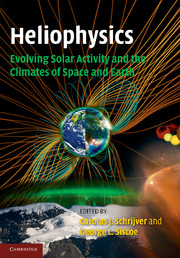Book contents
- Frontmatter
- Contents
- Preface
- 1 Interconnectedness in heliophysics
- 2 Long-term evolution of magnetic activity of Sun-like stars
- 3 Formation and early evolution of stars and protoplanetary disks
- 4 Planetary habitability on astronomical time scales
- 5 Solar internal flows and dynamo action
- 6 Modeling solar and stellar dynamos
- 7 Planetary fields and dynamos
- 8 The structure and evolution of the three-dimensional solar wind
- 9 The heliosphere and cosmic rays
- 10 Solar spectral irradiance: measurements and models
- 11 Astrophysical influences on planetary climate systems
- 12 Assessing the Sun–climate relationship in paleoclimate records
- 13 Terrestrial ionospheres
- 14 Long-term evolution of the geospace climate
- 15 Waves and transport processes in atmospheres and oceans
- 16 Solar variability, climate, and atmospheric photochemistry
- Appendix I Authors and editors
- List of illustrations
- List of tables
- References
- Index
- Plates
7 - Planetary fields and dynamos
Published online by Cambridge University Press: 05 April 2013
- Frontmatter
- Contents
- Preface
- 1 Interconnectedness in heliophysics
- 2 Long-term evolution of magnetic activity of Sun-like stars
- 3 Formation and early evolution of stars and protoplanetary disks
- 4 Planetary habitability on astronomical time scales
- 5 Solar internal flows and dynamo action
- 6 Modeling solar and stellar dynamos
- 7 Planetary fields and dynamos
- 8 The structure and evolution of the three-dimensional solar wind
- 9 The heliosphere and cosmic rays
- 10 Solar spectral irradiance: measurements and models
- 11 Astrophysical influences on planetary climate systems
- 12 Assessing the Sun–climate relationship in paleoclimate records
- 13 Terrestrial ionospheres
- 14 Long-term evolution of the geospace climate
- 15 Waves and transport processes in atmospheres and oceans
- 16 Solar variability, climate, and atmospheric photochemistry
- Appendix I Authors and editors
- List of illustrations
- List of tables
- References
- Index
- Plates
Summary
Introduction
Over four centuries ago it was realized that the time-averaged direction of a compass needle is not affected by a force emanating from the sky, but by a magnetic field that is intrinsic to the Earth. The basic structure of the geomagnetic field and its slow variation with time was characterized long before magnetic fields were detected on other celestial bodies. By the middle of the twentieth century, the study of remanent magnetization of natural rocks had firmly established that the principal dipole component of the Earth's magnetic field had reversed its direction many times in the past.
Our understanding of the origin of the field by a dynamo process in the Earth's core has developed at a much slower pace, basically in parallel with that of astrophysical dynamos in general. Aside from understanding the intricate details of how a magnetic field is generated by a dynamo, we must ascertain that some fundamental requirements are fulfilled inside our planet. Geophysical observations have shown that one condition, namely the existence of an electrically conducting fluid region, is met inside the Earth, which has an outer core consisting of a liquid iron alloy. It is likely, but not completely certain, that all big planets have conducting fluid cores (see Fig. 7.5). However, some planets may not conform with another basic condition for a dynamo, namely sufficiently fast motion in the fluid layer.
- Type
- Chapter
- Information
- Publisher: Cambridge University PressPrint publication year: 2010



